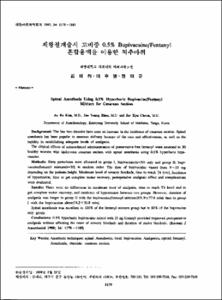KUMEL Repository
1. Journal Papers (연구논문)
1. School of Medicine (의과대학)
Dept. of Anesthesiology & Pain Medicine (마취통증의학)
제왕절개술시 고비중 0.5% Bupivacaine/Fentanyl 혼합용액을 이용한 척추마취
- Keimyung Author(s)
- Kim, Ae Ra; Cheun, Jae Kyu
- Journal Title
- 대한마취과학회지
- Issued Date
- 1998
- Volume
- 34
- Issue
- 6
- Abstract
- Background: The last two decades have seen an increase in the incidence of cesarean section. Spinal anesthesia has been popular in cesarean delivery because of the ease and effectiveness, as well as the rapidity in estabilishing adequate levels of analgesia. The clinical effects of subarachnoid administeration of preservative-free fentanyl were assessed in 30 healthy women who underwent cesarean section with spinal anesthesia using 0.5% hyperbaric bupi-vacaine.
Methods: Sixty parturients were allocated to group I; bupivacaine(n=30) only and group II; bupi-vacaine/fentanyl mixture(n=30) in random order. The dose of bupivacaine varied from 9~10 mg depending on the patients height. Maximum level of sensoiy blockade, time to reach T4 level, incidence of hypotension, time to get complete motor recovery, perioperative analgesic effect and complications were evaluated.
Results: There were no differences in maximum level of analgesia, time to reach T4 level and to get complete motor recovery, and incidence of hypotension between two groups. However, duration of analgesia was longer in group II with the bupivacaine/fentanyl mixture(191.9±77.6 min) than in group I with the bupivacaine alone(74.2±30.8 min). Spinal anesthesia was excellent in 100% of the fentanyl mixture group but in 80% of the bupivacine only group.
Conclusions: 0.5% hyperbaric bupivacaine mixed with 25 ㎍ fentanyl provided improved perioperative analgesia without affecting the onset of sensory blockade and duration of motor blockade.
- Alternative Title
- Spinal Anesthesia Using 0.5% Hyperbaric Bupivacine/Fentanyl Mixture for Cesarean Section
- Publisher
- School of Medicine
- Citation
- 김애라 et al. (1998). 제왕절개술시 고비중 0.5% Bupivacaine/Fentanyl 혼합용액을 이용한 척추마취. 대한마취과학회지, 34(6), 1179–1185. doi: 10.4097/kjae.1998.34.6.1179
- Type
- Article
- ISSN
- 0302-5780
- Appears in Collections:
- 1. School of Medicine (의과대학) > Dept. of Anesthesiology & Pain Medicine (마취통증의학)
- 파일 목록
-
-
Download
 oak-bbb-816.pdf
기타 데이터 / 420.88 kB / Adobe PDF
oak-bbb-816.pdf
기타 데이터 / 420.88 kB / Adobe PDF
-
Items in Repository are protected by copyright, with all rights reserved, unless otherwise indicated.